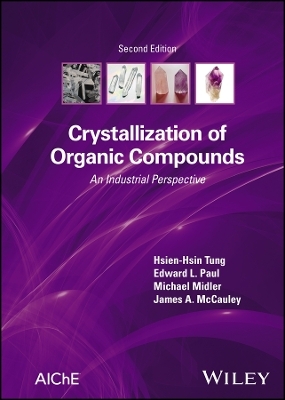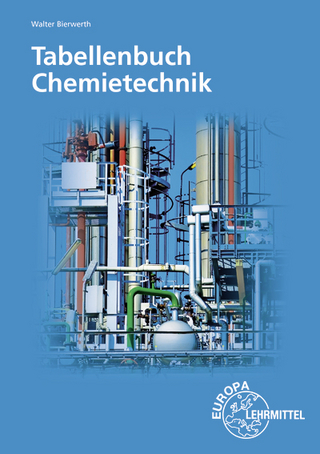
Crystallization of Organic Compounds
Wiley-AIChE (Verlag)
978-1-119-87946-6 (ISBN)
Based on the authors’ hands-on experiences as process engineers, through the use of case studies and examples of crystallization processes, ranging from laboratory development through manufacturing scale-up, Crystallization of Organic Compounds guides readers through the practical applications of crystallization and emphasizes strategies that have proven to be successful, enabling readers to avoid common pitfalls that can render standard procedures unsuccessful.
Most chapters feature multiple examples that guide readers, step by step, through the crystallization of active pharmaceutical ingredients (APIs), including an analysis of the major methods of carrying out crystallization operations, their strengths and potential issues, as well as numerous examples of crystallization processes from development through manufacturing scale.
Advancements in the field of crystallization have been integrated throughout the book in the newly revised Second Edition to ensure the content adequately reflects current state-of-the-art industrial know-hows and practice. The new edition also adds chapters addressing downstream operations after the crystallization, including filtration/washing and drying, together with industrial use cases.
Crystallization of Organic Compounds includes detailed information on:
Solubility and solid behavior, covering phase rule, polymorph, salt/co-crystal, chiral resolution and in-silico solubility prediction; and kinetics, covering seed, supersaturation, nucleation, crystal growth and model-based experimental design
Critical issues in the crystallization practice, covering oiling out, seeding/wet-milling, agglomeration/aggregation, mixing scale-up and quality-by-design principles
Cooling, anti-solvent, evaporation and reactive crystallization process design, covering batch and continuous operations with industrial examples
Special applications, covering crystallization with ultrasound, reaction selectivity enhancement, and computation fluid dynamics, and solid dispersion
With highly practical coverage of the subject, Crystallization of Organic Compounds is an essential resource for engineers and chemists involved with the development, scaling, or operation of crystallization process in the pharmaceutical and fine chemical industries, particularly those with degrees in chemical engineering and chemistry.
Hsien-Hsin Tung, PhD, is the co-founder of AcrysPharm, LLC. He founded the crystallization lab. at Merck and center of excellence of particle engineering at AbbVie. Edward L. Paul, PhD, (deceased) was retired Director of Chemical Engineering R & D at Merck Research Laboratories. Michael Midler, PhD, (deceased) was retired Senior Investigator, Chemical Engineering R&D at Merck. James A. McCauley, PhD, was a senior investigator in the Analytical R & D at Merck until his retirement, after which he became an adjunct professor in the Department of Chemical and Biochemical Engineering at Rutgers University.
Preface ix
1. Introduction to Crystallization 1
1.1 Crystal Properties and Polymorphs (Chapters 2 and 3) 3
1.2 Nucleation and Growth Kinetics (chapter 4) 4
1.3 Mixing and Scale- Up (Chapter 5) 4
1.4 Critical Issues and Quality by Design (Chapter 6) 5
1.5 Crystallization Process Options (Chapters 7–10) 6
1.6 Downstream Operations (Chapters 11 And 12) 12
1.7 Special Applications (chapter 13) 13
2. Properties 15
2.1 Solubility 15
2.2 Supersaturation, Metastable Zone, and Induction Time 26
2.3 Oil, Amorphous, and Crystalline States 30
2.4 Polymorphism 36
2.5 Solvate 40
2.6 Solid Compound, Solid Solution, and Solid Mixture 42
2.7 Inclusion and Occlusion 45
2.8 Adsorption, Hygroscopicity, and Deliquesce 47
2.9 Crystal Morphology 50
2.10 Partical Size Distribution and Surface Area 53
3. Polymorphism 57
3.1 Phase Rule 57
3.2 Phase Transition 58
3.3 Prediction of Crystal Structure and its Formation 60
3.4 Selection and Screening of Crystal Forms 66
3.5 Examples 75
Example 3.1 Indomethacin 76
Example 3.2 Sulindac 77
Example 3.3 Losartan 79
Example 3.4 Finasteride 81
Example 3.5 Ibuprofen Lysinate 83
Example 3.6 HCl Salt of a Drug Candidate 84
Example 3.7 Second HCl Salt of a Drug Candidate 87
Example 3.8 Prednisolone t- Butylacetate 91
Example 3.9 Phthalylsulfathiazole 93
4. Kinetics 95
4.1 Supersaturation and Rate Processes 96
4.2 Nucleation 97
4.3 Crystal Growth and Agglomeration 105
4.4 Nucleate/Seed Aging and Ostwald Ripening 116
4.5 Delivered Product: Purity, Cystal Form, Size and Morphology, and Chemical and Physical Stability 119
4.6 Design of Experiment (DOE)— Model- Based Approach 119
4.7 Model- Free Feedback Control 123
5. Mixing and Crystallization 125
5.1 Introduction 125
5.2 Mixing Considerations and Factors 126
5.3 Mixing Effects on Nucleation 130
5.4 Mixing Effects on Crystal Growth 135
5.5 Mixing Distribution and Scale- Up 139
5.6 Crystallization Equipment 141
5.7 Process Design and Examples 150
Example 5.1 Mixing Impact on Crystallization Kinetics 150
Example 5.2 Mixing Scale- Up Impact on Particle Size 151
6. Critical Issues and Quality by Design 155
6.1 Quality By Design 155
6.2 Basic Properties 156
6.3 Seed 158
6.4 Supersaturation 162
6.5 Mixing and Scale— Selection of Equipment and Operating Procedures 172
6.6 Strategic Considerations for Crystallization Process Development 174
6.7 Summary of Critical Issues 176
7. Cooling Crystallization 177
7.1 Batch Operation 177
7.2 Continuous Operations 183
7.3 Process Design— Examples 187
Example 7.1 Intermediate in a Multistep Synthesis 187
Example 7.2 Pure Crystallization of an API 191
Example 7.3 Crystallization Using the Heel from the Previous Batch as Seed 194
Example 7.4 Resolution of Ibuprofen Via Stereospecific Crystallization 195
Example 7.5 Crystallization of Pure Bulk with Polymorphism 199
Example 7.6 Continuous Separation of Stereoisomers 201
8. Evaporative Crystallization 207
8.1 Introduction 207
8.2 Solubility Diagrams 207
8.3 Factors Affecting Nucleation and Growth 210
8.4 Scale- Up 211
8.5 Equipment 212
8.6 Process Design and Examples 215
Example 8.1 Crystallization of a Pharmaceutical Intermediate Salt 215
Example 8.2 Crystallization of the Sodium Salt of a Drug Candidate 217
Example 8.3 API Hydrate with Low Water Solubility 219
9. Anti- solvent Crystallization 223
9.1 Operation 223
9.2 In- Line Mixing Crystallization 228
9.3 Process Design and Examples 229
Example 9.1 Crystallization of an Intermediate 229
Example 9.2 Rejection of Isomeric Impurities of Final Bulk Active Product 231
Example 9.3 Crystallization of a Pharmaceutical Product with Strong Nucleation and Poor Growth Characteristics 234
Example 9.4 Impact of Solvent and Supersaturation on Particle Size and Crystal Form 238
Example 9.5 Crystallization of an API Using Impinging Jets 241
Example 9.6 Crystallization of a Pharmaceutical Product Candidate Using an Impinging Jet with Recycle 245
Example 9.7 In Situ Wet Seed and Particle Generation Using In- line Mixer 249
10. Reactive Crystallization 253
10.1 Introduction 253
10.2 Control of Particle Size 255
10.3 Key Issues in Organic Reactive Crystallization 256
10.4 Creation of Fine Particles— In- Line Reactive Crystallization 264
10.5 Process Design and Scale- Up 267
Example 10.1 Reactive Crystallization of an API 267
Example 10.2 Reactive Crystallization of an Intermediate 270
Example 10.3 Reactive Crystallization of a Sodium Salt of an API 272
Example 10.4 Reactive Crystallization of an API 275
11. Filtration 277
11.1 Introduction 277
11.2 Basic Properties 278
11.3 Kinetics 280
11.4 Process Design and Scale- Up 290
Example 11.1 Design of Cake Wash Composition and Wash Mode 293
12. Drying 297
12.1 Introduction 297
12.2 Basic Properties 298
12.3 Kinetics 305
12.4 Process Design and Scale- Up 309
Example 12.1 Scale- Up— Residual Solvent 311
Example 12.2 Scale- Up— Particle Agglomeration and Fracturing 314
13. Special Applications 317
13.1 Introduction 317
13.2 Crystallization with Supercritical Fluids 318
13.3 Resolution of Stereo- Isomers 319
13.4 Wet Mills in Crystallization 320
13.5 Computational Fluid Dynamics in Crystallization 321
13.6 Solid Dispersion— Crystalline and/or Amorphous Drugs 321
13.7 Process Design and Examples 322
Example 13.1 Sterile Crystallization of Imipenem 322
Example 13.2 Enhanced Selectivity of a Consecutive–Competitive Reaction by Crystallization of the Desired Product During the Reaction 327
Example 13.3 Applying Solubility to Improve Reaction Selectivity 330
Example 13.4 Melt Crystallization of Dimethyl Sulfoxide 335
Example 13.5 Freeze Crystallization of Imipenem 338
Example 13.6 Continuous Separation of Stereoisomers 342
Example 13.7 Hybrid Solid Dispersion 349
References 355
Index 363
| Erscheinungsdatum | 10.07.2023 |
|---|---|
| Sprache | englisch |
| Gewicht | 1297 g |
| Themenwelt | Naturwissenschaften ► Chemie ► Technische Chemie |
| Technik | |
| ISBN-10 | 1-119-87946-9 / 1119879469 |
| ISBN-13 | 978-1-119-87946-6 / 9781119879466 |
| Zustand | Neuware |
| Haben Sie eine Frage zum Produkt? |
aus dem Bereich


